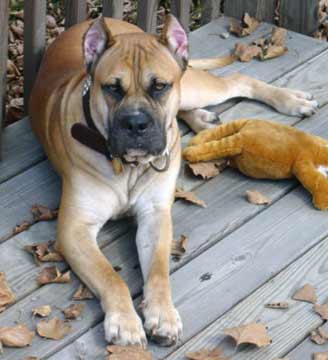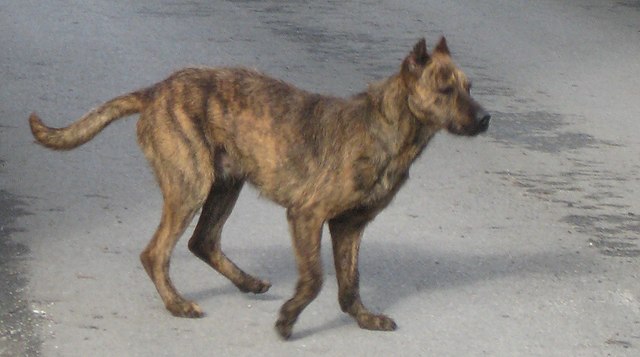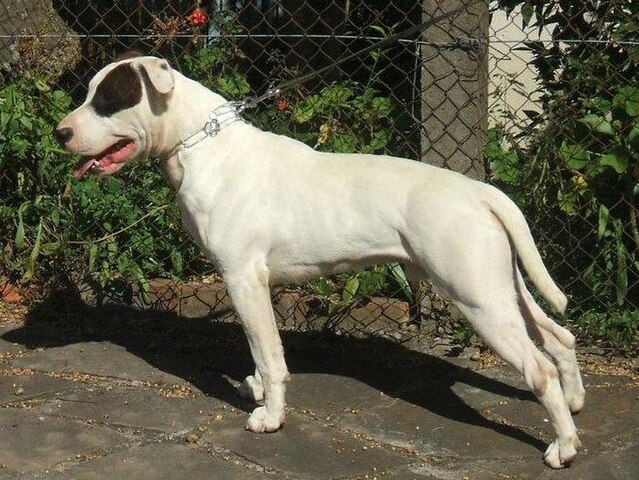While the Northern Inuit Dog is a very rare breed, it’s possible you have seen one on TV if you watched Game of Thrones! Members of the breed played the Direwolves in the series (although the size was enhanced through CGI once the characters grew). The breed’s history dates back to the early 1980’s, when several dogs unspecified of origin were imported from North America into Britain. The goal was to create a breed which could work long hours as well as function as a pet – following the example of Inuit people who crossed dogs with wolves for a similar purpose. It should be noted, however, that Northern Inuits were primarily created as pets and while they can be given tasks their almost-entire purpose is that of a companion. While there is no wolf ancestry in the Northern Inuit, “wolf-like” breeds such as Siberians, Malamutes and Shepherds were definitely involved in the creation.
The Northern Inuit tends to do best in colder climates as he has a thick double coat and is highly related to Northern breeds, however he can live in warmer parts of the country with some care and common sense. Keeping him in air conditioning, making sure he always has water, scheduling walks for morning and evenings and giving him supervised access to a pool on extra hot days are all ways that can help accommodate this winterized breed to a warmer climate. Either way, make sure to never shave his coat as this will only make things worse for the dog!
Northern Inuit Dogs are intelligent but also known to become bored easily which means that training requires incorporating plenty of enthusiasm and diversity. They also are strong-willed, stubborn, and have a fairly high prey drive to boot. For this reason, they are not recommended for novice owners. That said, they are fully capable of passing a basic CGC test or reaching high levels of obedience when an owner puts in the work! They are also talented enough to participate in dog sports such as bikejouring, agility, sledding, scent work and canicross. Furthermore, some Northern Inuits have even been used as assistance dogs while others have done therapy work – which speaks as much as to their sociability as their trainability. Because they can reach giant-status in terms of size, every Inuit must be given basic obedience training at the very least!
Northern Inuits are often great with children although are not recommended for small kids because of their size and strength. Many also do well with other dogs who can put up with their rough (not aggressive) play style. They do have prey drive and may not be great around small pets although many owners with cats have had success integrating the two. Socialization to cats while the dog is still a young puppy can help encourage a smoother interaction down the line.
The Northern Inuit Dog, despite his intimidating wolf-like appearance, is not a guard dog for he is far too friendly and trusting. He should never be outright aggressive without very good reason. This loyal, friendly and affectionate dog is overall a lover and not a fighter. This said, he is likely to make noise which may deter some would-be intruders. Although he doesn’t bark much, many Northern Inuits howl – loudly! Which is something to consider if one is living close to neighbors…
Northern Inuits only require a moderate amount of exercise. One long walk a day is sufficient for most, although they can enjoy longer excursions with their owners such as hiking. Like all giant breeds, care should be taken when they are puppies not to over-exercise them as their growing joints are not built to handle super strenuous tasks. Along with physical exercise, they also need mental exercise as well which can take the form of training or interactive “brain games”. This breed is active outdoors although has the capability of being calm and relaxed in the house.
Northern Inuit Dogs exhibit some characteristics of other Northern breeds such as digging in the yard, but overall do not have all of the Northern spitz traits. This includes a lack of both typical “bad behaviors” of spitz breeds (wandering, hyperactivity), as well as “good features” such as sled pulling abilities. While a Northern Inuit Dog can pull a sled, it is unlikely he will possess the same endurance as his cousins who were bred for this particular task. This breed was created to be a pet rather than to be a workhorse, which puts him in a different category when it comes to dog ownership.
Northern Inuits are extremely social animals and known for following their owners from room to room. They are also less likely to try to escape and wander the neighborhood since they prefer to be in the company of “their people”. While flattering to many, be aware that this high social desire also makes them more prone to separation anxiety – the downside to dogs with “velcro personalities”. They will not do well in households where everyone is at work for long hours!




